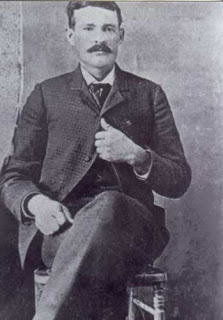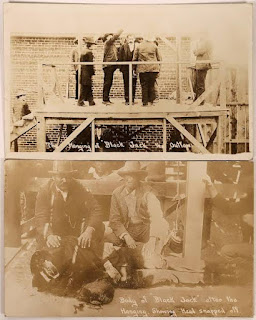Thomas Edward Ketchum the (Black Jack)_world history and facts
Thomas Edward Ketchum the (Black Jack)
Thomas Edward Ketchum (known as Black Jack; October 31, 1863 – April 26, 1901) was an American cowboy who later became an outlaw. He was executed in 1901 for attempted train robbery.
The execution by hanging was botched; he was decapitated because the executioner used a rope that was too long.
Tom Ketchum was born in San Saba County, Texas. He left Texas in 1890, possibly after committing a crime. He worked as a cowboy in the Pecos River Valley of New Mexico, where by 1894, his older brother, Sam Ketchum, had joined him.
Black Jack and a group of others were named as the robbers of an Atchison, Topeka and Santa Fe Railway train that was en route to Deming, New Mexico Territory, in 1892 with a large payroll aboard.
The gang supposedly robbed the train just outside Nutt, New Mexico Territory, a water station twenty miles (32 km) north of Deming.
Black Jack and his gang would often visit the ranch of Herb Bassett, near Brown's Park, Colorado, who was known to have done business with several outlaws of the day, having supplied them with beef and fresh horses.
Herb Bassett was the father of female outlaws Josie Bassett and Ann Bassett, who were girlfriends to several members of Butch Cassidy's Wild Bunch gang. One of Ann Bassett's boyfriends and future Wild Bunch gang member, Ben Kilpatrick, began riding with Black Jack's gang about that time.
Outlaw "Bronco Bill" Walters, later noted for the legend of his "hidden loot" near Solomonville, Arizona, is also believed to have begun riding with the gang at this time.
The second major crime attributed to Tom was the murder of a neighbor, John N. "Jap" Powers, in Tom Green County, Texas, on December 12, 1895. However, information at the Sutton Historical Society in Texas, says that Will Carver and Sam Ketchum were the ones actually accused of killing Powers in Knickerbocker.
Fearing the law, they closed their joint saloon and gambling venture in San Angelo, and hit the outlaw trail. Within six months, Mrs. Powers and her lover, J. E. Wright, were arrested for the murder, but it was too late for Carver and the Ketchums.
By late 1895, outlaw Harvey "Kid Curry" Logan and his brother Lonnie Curry were members of Black Jack's gang. However, in early 1896, a dispute concerning their share of robbery loot prompted the Currys to leave the gang.
It is alleged that Ketchum was involved with the February 1, 1896, disappearance and presumed murders of Albert Jennings Fountain and his son Henry Fountain of Las Cruces, New Mexico.
In early June 1896, after working for the famed Bell Ranch in New Mexico, Tom and Sam Ketchum, and possibly others, robbed a combined store and post office at Liberty, New Mexico, northwest of present-day Tucumcari. According to contemporary accounts, the Ketchums rode into Liberty on June 12 and purchased supplies.
That evening, a thunderstorm began, and they returned to the store, owned by Morris and Levi Herzstein, who invited them to take shelter.
Returning the next morning to open his store, Levi Herzstein found that both the store and post office had been burglarized. After gathering a posse, Herzstein set out on the outlaws' trail. The posse, composed of just four men, took the two outlaws by surprise in the Plaza Largo arroyo, where a shootout immediately began.
Seconds later both Levi Herzstein and Hermenejildo Gallegos lay dead. Seeing his comrades fall, Anastacio Borgue turned his horse and rode out of the arroyo. Placido Gurulé, the fourth member of the posse, also survived to give an account.
Gurulé said he had been struck by a .30-30 bullet that knocked him off his horse. He landed on the ground with a blow that knocked the wind out of him. He lay in a semiconscious state as Black Jack Ketchum emptied his rifle into the bodies of Levi Herzstein and Hermenejildo Gallegos.
Tom and Sam Ketchum were never tried for the killings at the Plaza Largo arroyo, but Morris Herzstein reportedly was present to witness the hanging of Black Jack Ketchum in 1901.
Morris Herzstein moved to Clayton shortly after the killing in Liberty, and finally into the Texas Panhandle area. This is memorialized by the inscription on a shoe brush: "Herzstein's Clayton, New Mexico -- Dalhart, Texas.
If it's from Herzstein's it's correct." Morris was the father of Albert Herzstein, who became one of the founders of Big 3 Industries in Houston, and is the man who helped the museum in Clayton to become a reality years later.
On August 16, 1899, Tom Ketchum, supposedly knowing nothing of the July 11 hold-up which ended in the death of his brother Sam, single-handedly attempted to rob the same train again at the same place and in the same way that he and Sam and others had robbed it just a few weeks earlier.
The train conductor, Frank Harrington, saw Tom approaching the moving train. He recognized him, grabbed a shotgun, and shot Tom in the arm, knocking him off his horse. The train continued, and the next day a posse came out and found Tom beside the tracks, badly wounded.
He was transported to medical facilities at Trinidad, Colorado, and his right arm had to be amputated. He was nursed back to health and then sent to Clayton, New Mexico Territory, for trial.[citation needed]
At the trial, Ketchum was convicted of attempted train robbery and sentenced to death. He was the only person ever hanged in Union County, New Mexico Territory (now Union County, New Mexico).
He was also the only person who suffered capital punishment for the offense of "felonious assault upon a railway train" in New Mexico Territory (which did not become a state until 1912). Later, the law was found to be unconstitutional.[citation needed]
Ketchum was executed by hanging in Clayton. Nobody in Clayton had any experience in conducting hangings; the rope was too long, and since Ketchum had gained a significant amount of weight during his time in jail, he was decapitated when he dropped through the trap door.[5]
Ketchum's last words were reported by the San Francisco Chronicle as: "Good-bye. Please dig my grave very deep. All right; hurry up."[5]
An account of the event from Sheriff Salome Garcia detailed the scene[6]:
“He walked firmly up the steps, saying as he went up, "Dig my grave deep, boys." Stepping upon the trap door he asked for the black cap, and it was placed over his head but [it] had to be removed to permit the rope to be placed on his neck, and while they delayed somewhat he became impatient and said, "Let her go boys."....
The sheriff cut the trigger rope with a hatchet, and his body shot down with all its 215 pounds of weight.
Everyone within or without the stockade held their breath, and their hearts gave a great bound of horror when it was seen that his head had been severed from his body by the fall. His body alighted squarely upon its feet, stood for a moment, swayed and fell and then great streams of red, red blood spurted from his severed neck, as if to shame the very ground upon which it poured.
The head rolled aside and the rope, released, bounded high and fell with a thud upon the scaffold from whence it came.”
A popular postcard was made showing the body. Afterwards his head was sewn back onto the body for viewing, and he was interred at the Clayton Cemetery.
Reference:
Texas State Historical Association (TSHA)
"Tom Ketchum and His Gang". History Net. June 12, 2006. Retrieved December 29, 2014.
"W.H. Love". Officer Memorial Page. Archived from the original on December 21, 2016. Retrieved December 29, 2014.
"Ed Farr". Officer Memorial Page. Archived from the original on December 21, 2016. Retrieved December 29, 2014.





.jpg)

.jpeg)






Comments
Post a Comment